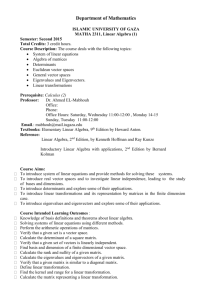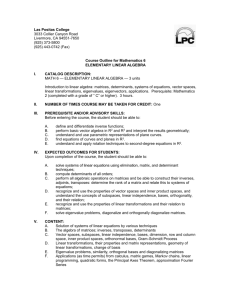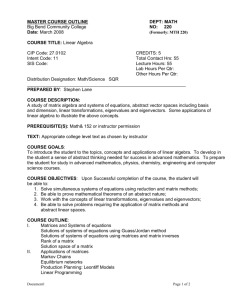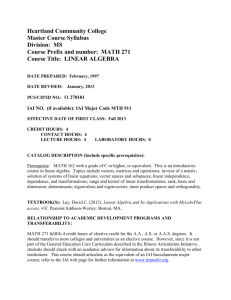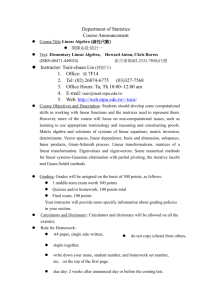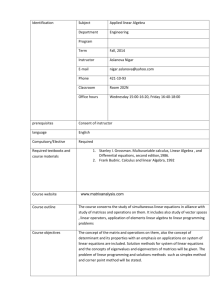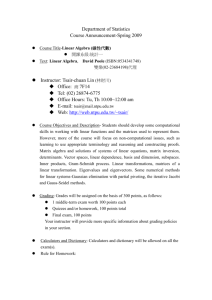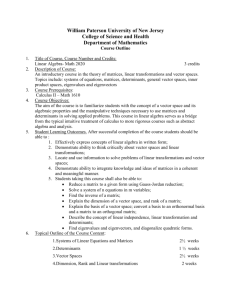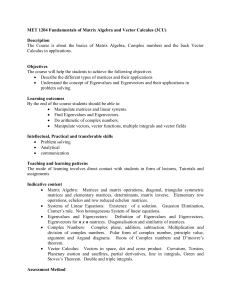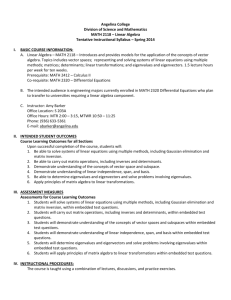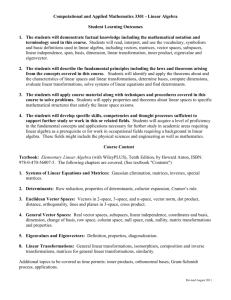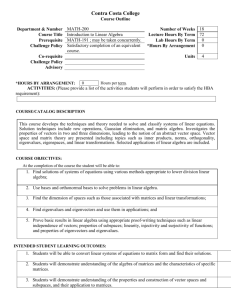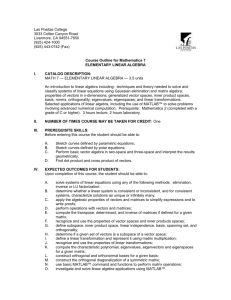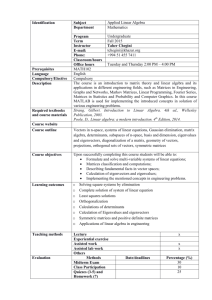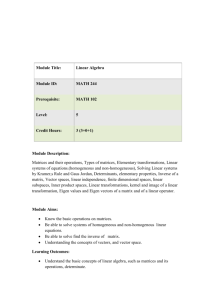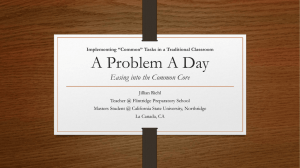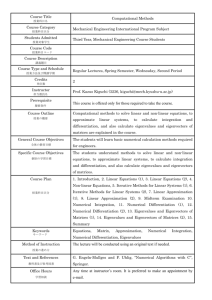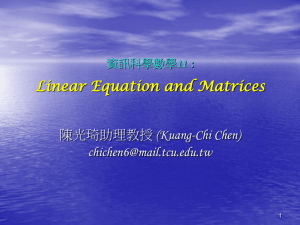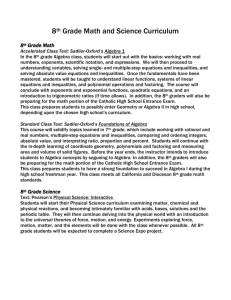Elementary Linear Algebra with Computer
advertisement
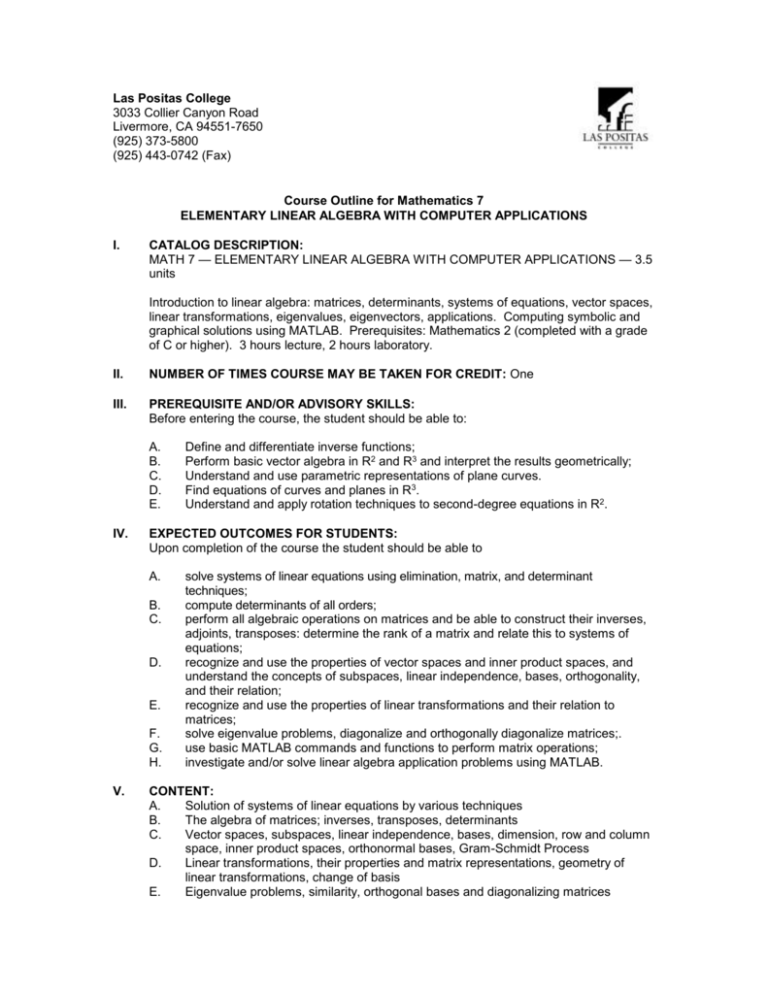
Las Positas College 3033 Collier Canyon Road Livermore, CA 94551-7650 (925) 373-5800 (925) 443-0742 (Fax) Course Outline for Mathematics 7 ELEMENTARY LINEAR ALGEBRA WITH COMPUTER APPLICATIONS I. CATALOG DESCRIPTION: MATH 7 — ELEMENTARY LINEAR ALGEBRA WITH COMPUTER APPLICATIONS — 3.5 units Introduction to linear algebra: matrices, determinants, systems of equations, vector spaces, linear transformations, eigenvalues, eigenvectors, applications. Computing symbolic and graphical solutions using MATLAB. Prerequisites: Mathematics 2 (completed with a grade of C or higher). 3 hours lecture, 2 hours laboratory. II. NUMBER OF TIMES COURSE MAY BE TAKEN FOR CREDIT: One III. PREREQUISITE AND/OR ADVISORY SKILLS: Before entering the course, the student should be able to: A. B. C. D. E. IV. EXPECTED OUTCOMES FOR STUDENTS: Upon completion of the course the student should be able to A. B. C. D. E. F. G. H. V. Define and differentiate inverse functions; Perform basic vector algebra in R2 and R3 and interpret the results geometrically; Understand and use parametric representations of plane curves. Find equations of curves and planes in R3. Understand and apply rotation techniques to second-degree equations in R2. solve systems of linear equations using elimination, matrix, and determinant techniques; compute determinants of all orders; perform all algebraic operations on matrices and be able to construct their inverses, adjoints, transposes: determine the rank of a matrix and relate this to systems of equations; recognize and use the properties of vector spaces and inner product spaces, and understand the concepts of subspaces, linear independence, bases, orthogonality, and their relation; recognize and use the properties of linear transformations and their relation to matrices; solve eigenvalue problems, diagonalize and orthogonally diagonalize matrices;. use basic MATLAB commands and functions to perform matrix operations; investigate and/or solve linear algebra application problems using MATLAB. CONTENT: A. Solution of systems of linear equations by various techniques B. The algebra of matrices; inverses, transposes, determinants C. Vector spaces, subspaces, linear independence, bases, dimension, row and column space, inner product spaces, orthonormal bases, Gram-Schmidt Process D. Linear transformations, their properties and matrix representations, geometry of linear transformations, change of basis E. Eigenvalue problems, similarity, orthogonal bases and diagonalizing matrices Page 2 Course Outline for Math 7 ELEMENTARY LINEAR ALGEBRA WITH COMPUTER APPPLICATOINS F. G. Applications (as time permits) from calculus, matrix games, Markov chains, linear programming, quadratic forms, the Principal Axes Theorem, approximation Fourier Series Computing exercises to include some of the following and instructor chosen applications 1. MATLAB Basics – Vectors and Matrices 2. Reduced Row Echelon Form 3. Solving systems Ax=b 4. LU Factorizations 5. Basis for row or column space or null space 6. Characteristic polynomial, eigenvalues, al eigenvectors 7. Population Modeling 8. Least squares approximations VI. METHODS OF INSTRUCTION: A. Lecture with computer or graphing calculator demonstrations B. Classroom discussion C. Collaborative learning activities where applicable D. Computer lab exercises VII. TYPICAL ASSIGNMENTS: A. Homework assignments from textbook 1. Section 2.4, exercise set pages 112-113, 1, 5, 4-13 odd, 15, 16, 20 2. Section 6.1, exercise set pages 284-285 1-10 all B. Typical collaborative activity 3. Let T : M m, n M n, m be the function that maps an m x n matrix A to its 4. T transpose. That is T ( A) A . Show that T is a linear transformation. Each of the sets of objects and their operations below are not vector spaces. Find one axiom that each one fails. Justify your answer: The set of all ordered pairs ( x , y ) , with the operations C. VIII. x1, y1 x2 , y2 x1,0 and c( x, y ) (cx, cy ) Use MATLAB to compute eigenvalues and basic eigenvectors numerically and; if possible exactly. Confirm your answer by showing that the computed eigenvalues satisfy the characteristic equation. EVALUATION: A. Methods 1. Examinations 2. Quizzes 3. Homework 4. Collaborative Learning Activities 5. Computer Assignments B. Frequency of evaluation 1. Recommend 3 or 4 exam plus final examination 2. Homework for each section covered C. Types of Problems 1. Homework-In each part find the largest possible value for the rank and the smallest possible value for the nullity of A. (a) A is 4 X 4 (b) A is 3 X 5 2. Quizzes- #8 section 1.1 For which value(s) of the constant k does the following system of linear equations have no solution? Exactly one solutions? Infinitely many solutions? 3. Exams x y3 2x 2 y k Page 3 Course Outline for Math 7 ELEMENTARY LINEAR ALGEBRA WITH COMPUTER APPPLICATOINS a. For which real numbers k, is the set S k , 1, 1, 1, 0, 1, 1, 1, 3k 2 b. of vectors in R linearly independent? Use the Gram-Schmidt orthonormalization process to transform the basis 1, 0, 1, 2, 3, 5, 0, 2, 1 into an orthonormal basis. IX. TYPICAL TEXTS: A. Anton, Howard Elementary Linear Algebra, 8th Edition. New York: Wiley, 2000. B. Larson and Edwards, Elementary Linear Algebra, 4th Edition. Boston: Houghton Mifflin, 2000. C. Lay, Linear Algebra and its Applications, 2nd Edition. New York: Addison Wesley, 1999. X. OTHER MATERIALS REQUIRED OF STUDENTS: A calculator capable of simplifying matrices is required Computer access card Creation Date: Revision Date: MATH 7 2/01 10/01
